Professional binoculars for astronomy, travel and watching events on Earth.
Stargazing binoculars for astronomy can be a terrific replacement for a telescope. They perform identical functions while offering a previously unseen viewing experience.
Binoculars are perfectly suitable for star-watching due to their portability and produced image quality in poor lighting.
Regardless of whether you’re only preparing for your first stargazing adventure or have spent hundreds of nights looking at the sky, you’re bound to find the best astronomy binoculars for yourself below.
They’re powerful enough to show you stars, planets and distant nebulae.
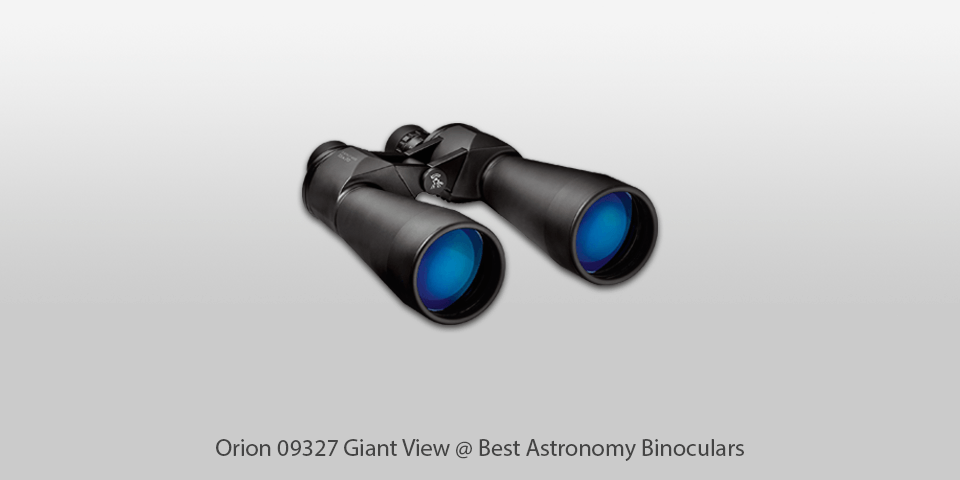
Magnification: 17x | Objective diameter: 70 mm | Field of view at 1000m: 64/210 metres/ft | Closest focusing distance: 22.9/75 metres/ft | Eye relief: 18 mm | Weight: 1815 g
⊕ Completely multi-coated optical elements
⊕ BAK-4 Porro prism passes HD light
⊕ Reliable barrels
⊕ Can focus each eyepiece separately
⊖ Tripod adapter needs to be purchased individually
These astronomical binoculars are packed in a durable aluminum casing meaning they’ll serve you for years. The included lenses are big and offer an aperture of 70mm.
Other than that, the 15-times zoom will help you enjoy cosmic and terrestrial bodies closer than ever before so that you can appreciate every single detail.
HD light transmission is another great feature offered by this model. The eyepieces are multi-coated and provide better contrast and resolution, while also focusing separately, which gives you superior precision compared to standard center-focus systems.
The water-resistant build guarantees you’ll be able to use the binoculars regardless of the weather. Meanwhile, the long 18-mm eye-relief helps glass wearers enjoy an unobscured image while wearing their eyeglasses or sunglasses.

Magnification: 15x | Objective diameter: 70 mm | Field of view at 1000m: 64/210 metres/ft | Closest focusing distance: 22.9/75 metres/ft | Eye relief: 17 mm | Weight: 2150 g
⊕ Multi-coated optical components
⊕ Premium BAK-7 Porro prisms
⊕ Terrific resolution
⊕ Includes a phone adapter
⊖ Lightweight tripod
⊖ Housing doesn’t seem to be very reliable
These are the best astronomy binoculars if you want to observe stars and celestial bodies that are situated further.
This model comes with 70-mm lenses that offer a magnification range from 13x to 39x, with you having complete control over the zoom degree. By simply rotating a knob, you can switch from viewing birds to looking at stars at night.
Other than that, the ESSLNB Giant offers a field of view of 288ft per 1000 yards. The binoculars also have a phone adapter made for astrophotography.
All you need to do is set the device using the tripod adapter, attach your phone, and start taking photos.
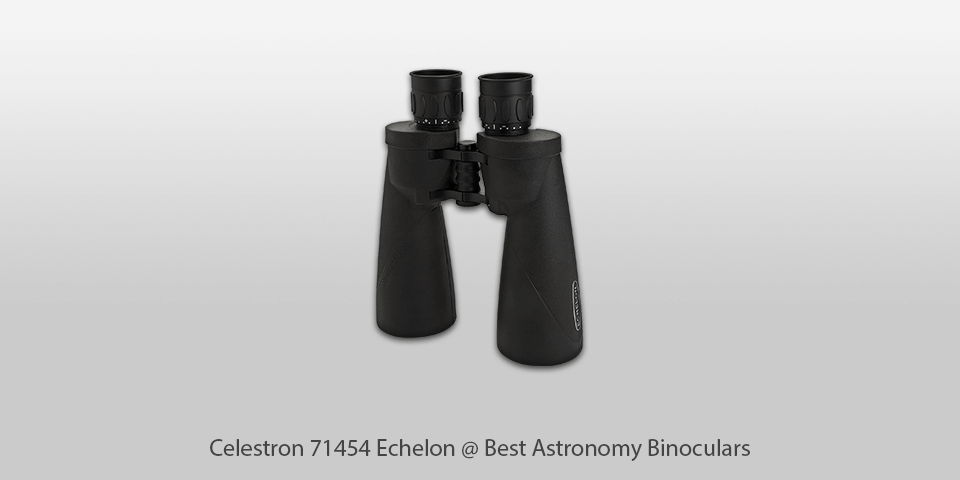
Magnification: 20x | Objective diameter: 70 mm | Field of view at 1000m: 48/157 metres/ft | Closest focusing distance: 100/328 metres/ft | Eye relief: 19.5 mm | Weight: 1870 g
⊕ High-quality build
⊕ 100% fog and waterproof
⊕ Very long eye-relief
⊕ Reliable, water-resistant carrying case
⊖ Individual focusing mechanism
⊖ Minimal focus distance is still quite large
While this brand is mostly known for producing telescopes, their product line also offers a series of both regular and celestial binoculars.
The latter are manufactured in the United States and are built on Japanese optics, which are all about quality in all aspects (design, image, material).
This 20x70 device offers completely multi-coated optical elements and high-end Bak-4 prisms that produce crisp and sharp images. The large eye-relief also makes these binoculars a great choice for people with glasses.
The device also has a rubberized exterior which makes it convenient to hold. They’re designed specifically with stargazers in mind.
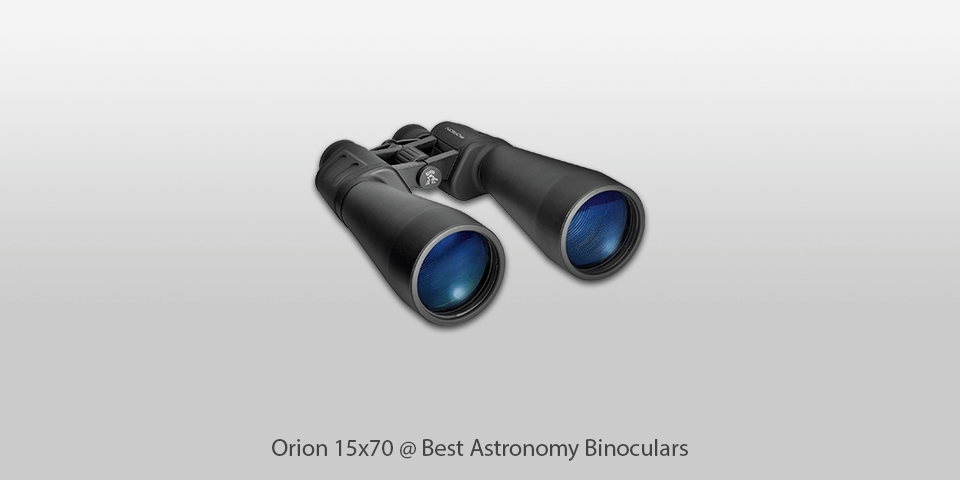
Magnification: 15x | Objective diameter: 70 mm | Field of view at 1000m: 64/210 metres/ft | Closest focusing distance: 9.1/30 metres/ft | Eye relief: 18 mm | Weight: 1406 g
⊕ Completely multi-coated optics
⊕ Impressive 15-times magnification
⊕ 18mm eye relief
⊕ Comes with a tripod L-adapter
⊖ Requires a tripod for convenient usage
These binoculars for stargazing are sold at an attractive price while offering all the specs you need. Supplied with 70mm objective lenses and 15x magnification, this product is the perfect pick.
The power offered by the Orion is even enough to see star clusters while looking at the sky in a light-polluted city. The light transmission and contrast are further improved thanks to the inclusion of BAK-4 prisms, completely poly-coated optical elements, and internal baffling.
It’s suited for eyeglass wearers due to the lengthy 18-mm eye relief that allows keeping the glasses on.
The package also comes with a tripod L-adapter that will make long viewing sessions more enjoyable and stable.
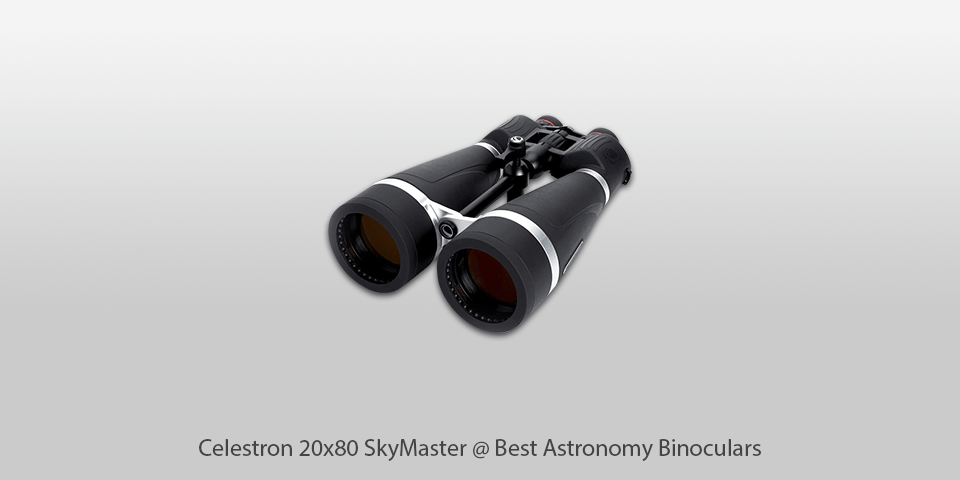
Magnification: 20x | Objective diameter: 80 mm | Field of view at 1000m: 51.2/168 metres/ft | Closest focusing distance: 20.2/66.3 metres/ft | Eye relief: 15.5 mm | Weight: 2267 g
⊕ Weather resistant
⊕ Enhanced light gathering in poor lighting
⊕ Great image brightness
⊕ 20X power secures increased resolution
⊖ Risk of developing a double image over time
⊖ Too heavy to use without a tripod
All products from the Celestron line come with BaK-4 Porro prisms and fully coated optical parts and this option is no exception.
The SkyMaster has 80-mm lenses and a maximum magnification value of 20x. Such characteristics make it arguably the best astronomy binoculars in its class.
The hinge, focus and eyepiece adjustments work smoothly and offer just the right amount of resistance to ensure you don’t accidentally ruin the focus.
One inclusion that you won’t see in other models is the interchangeable eyecups (you can pick between regular and winged ones).
The winged option is great at protecting your sight from stray light, but the caps need to be folded to put the rain guard-style caps on.
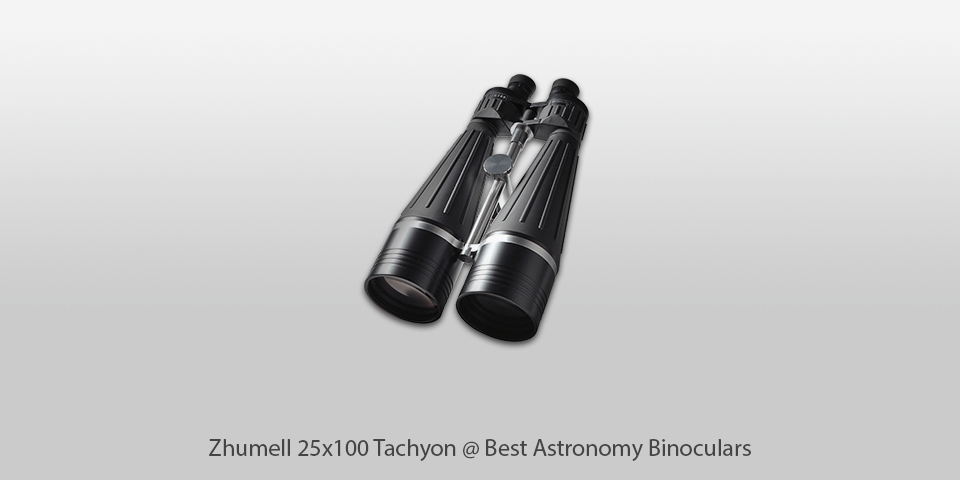
Magnification: 25x | Objective diameter: 100 mm | Field of view at 1000m: 40/132 metres/ft | Closest focusing distance: 54/177 metres/ft | Eye relief: 15.4 mm | Weight: 4535 g
⊕ Terrific light gathering
⊕ Attractive price and performance
⊕ Includes a convenient nice hard case
⊕ Compatible with standard 1.25-inch filters
⊖ Minimum IPD of about 60mm
⊖ Requires a reliable mount due to its weight
Packed with 25-times magnification, 100-mm objective lenses and an integrated tripod adapter, you’ll have no trouble viewing the craters on the moon, distant celestial objects and planets.
You’ll even be able to see some interstellar bodies. Additionally, this model is equipped with 1.25"" astronomy filters that make gazing at the moon, stars, nebulae and other objects even more enjoyable.
Tachyon offers a sturdy design and a water-resistant body. The grip is rubberized, so you can hold the binoculars tightly, never having to worry about accidentally dropping them.
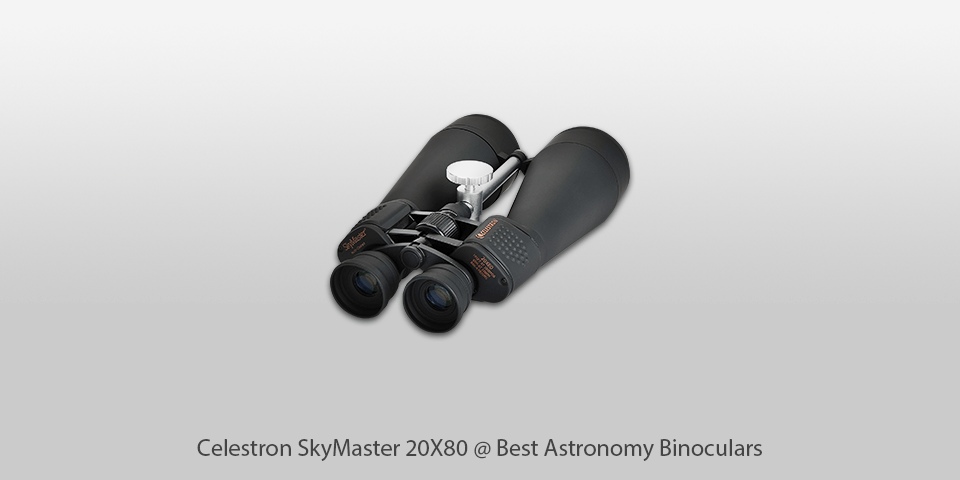
Magnification: 20x | Objective diameter: 80 mm | Field of view at 1000m: 59.4/195 metres/ft | Closest focusing distance: 33/108 metres/ft | Eye relief: 18 mm | Weight: 2127 g
⊕ Relatively broad field of view
⊕ Large eye-relief for comfort
⊕ Can be mounted on a tripod
⊕ Terrific exterior look
⊖ Quite heavy
⊖ The focuser has a small play
The Celestron SkyMaster 20x80 binoculars represent a professional device that stands out from other contenders for the title of the best binoculars for astronomy due to its large aperture.
It’s one of the most powerful optics suitable for ground-based and astronomic observations.
Thanks to the usage of BaK-4 prisms and multi-coated optics, the binoculars also offer improved contrast parameters.
The SkyMaster’s body is enhanced with rubberized plastic that ensures your hand doesn’t slip when you’re holding the binoculars.
This model has a true field of view of 3.7° and an eye-relief of 15mm that can’t be changed, which makes it comfortable to use for people, who wear glasses. The body of the binoculars has a special stem adapter that allows you to stabilize the device.
| Image | Name | Features | |
|---|---|---|---|
 |
Orion 09327 Giant View
Our Choice |
CHECK PRICE → | |
 |
ESSLNB Giant
Cheap |
CHECK PRICE → | |
 |
Celestron 71454 Echelon
Professional |
CHECK PRICE → |
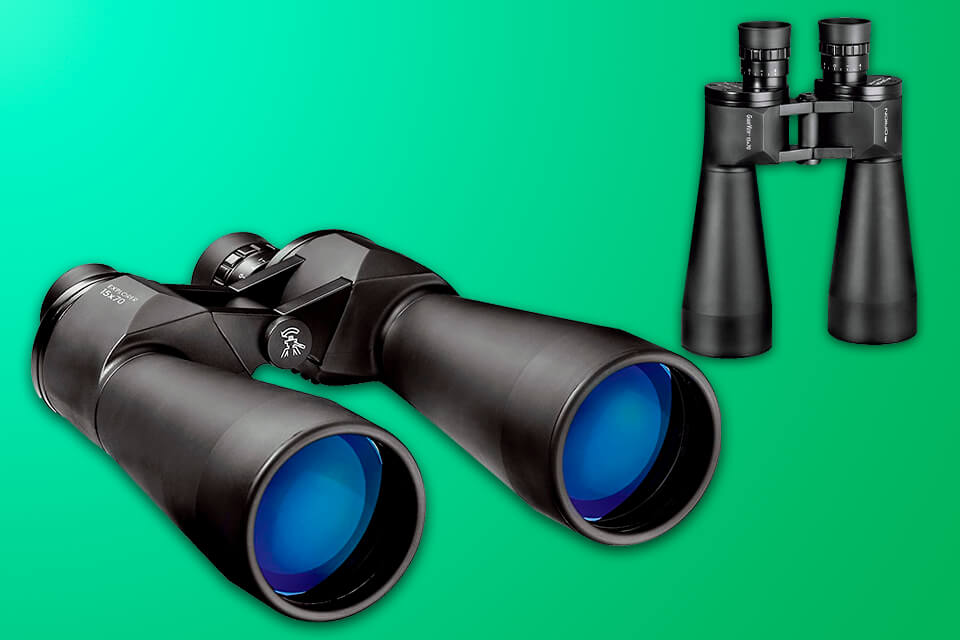
Eye relief covers the distance from the image to the last lens in the device’s eyepieces. This characteristic is particularly relevant if you usually wear eyeglasses.
Since you have no way to get closer to the lens, you require a model that has a lengthy eye relief. Another possible option is binoculars with adjustable eyecups.
Binoculars are meant to be used outdoors so most manufacturers ensure they’re built from sturdy materials. Give preference to stargazing binoculars that are made of high-quality metals and thick glass, as they have to be durable enough to survive an accidental drop or collision.
Binocular lenses typically have several layers of coating, as it’s used for minimizing reflections, improving contrast, and making the image sharper. Thus, you should pay close attention to what type of coating is offered by the star binoculars you’re looking at.
For the ultimate viewing experience, pick a model with completely multi-coated lenses. All of the lenses in such binoculars are covered with anti-reflection coating and offer the best possible brightness and contrast.
You can find out the maximum magnification level by looking at the number that ends with “x.” The higher the value, the more magnification you can get. Regardless of the distance, a device with more magnification power will make the object appear closer compared to less powerful binoculars.
Additionally, more magnification power also provides a clearer image thanks to the larger resolution. If you’re planning to look at celestial bodies that are very far away, the best astronomy binoculars for you would be ones that offer the maximum magnification power.
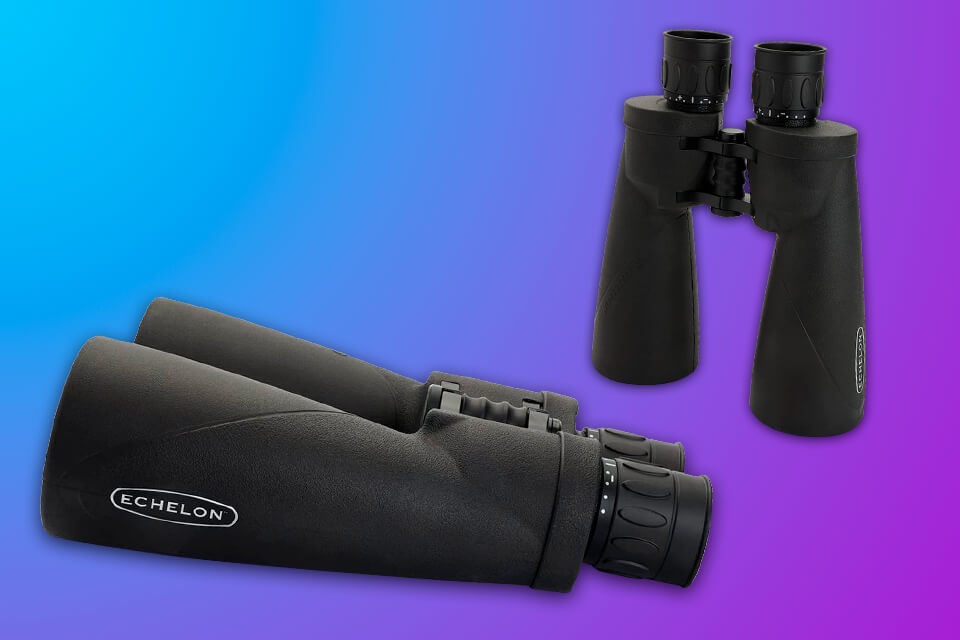
Size is a very important factor when picking binoculars for astronomy as the larger they are, the more detailed and closer the image you get to enjoy.
Additionally, bigger models receive more light, which makes them better suited for stargazing.
Small binoculars (below 10x10) are incapable of providing an adequate stargazing experience, as they’re mostly designed for ground-based observation, bird spotting, etc.
The only real drawback of bigger binoculars is how much they weigh. The biggest ones require a tripod if you want a stable image and the ability to use it for hours, as holding them in hands is only possible for limited periods.
While binoculars don’t offer the same level of magnification as telescopes, they can still be a great choice for astronomy. Unlike a telescope, they offer a bigger field of view, are far more portable, and cost significantly less.
Even though it takes a telescope to find Saturn’s rings, a pair of binoculars for star gazing does allow you to enjoy the planet's magnificent golden color. More experienced watchers can sometimes see Titan (Saturn's biggest moon). If you get the most powerful binoculars on the list and place them on a tripod, you’ll be able to see that Saturn isn’t actually round.
The Big Dipper is the constellation you can get the best look at, with Mizar and Alcor being visible in full detail. That said, you can view other constellations like the Little Dipper as well.
Yes, you can as it reflects a decent amount of sunlight without damaging your eyes. Since it’s also very close to Earth, you can even see specific craters with a pair of good binoculars.

 Rating
Rating